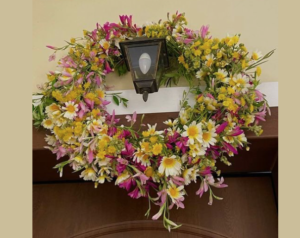1st MAY – customs and traditions
May 1st is a special day for Greeks, as well as a Public Holiday.
For many countries in Europe, May 1st is International Labor Day.
This is also the case in Greece, though for Greeks this day is more commonly called Protomagia meaning first of May
The improving weather and starting of summer is celebrated, after the colder and darker days of winter. And this year the winter had indeed many days with rain, snow, and clouds…
May 1st is one of the few non-religious public holidays in Greece, celebrated with flowers.
May Day is traditionally celebrated in the countryside, where friends and families gather for this high-point of spring — engaging in flower collection, picnics and fun in the sun. Young and old literally stream out of cities and towns to celebrate the official end of the winter period.
All types of wildflowers that blossom in the countryside are the stars of the day.
As it is a national holiday, everything is closed, with the exception of cafes and many tavernas.
May Day background
The custom of protomagia finds its origins in ancient Greece as a celebration of nature’s rebirth, spring, and flowers.
The name Maios (May) originated from the Goddess Maia, who is one of the seven stars which make up the constellation called Pleiades and is also the mother of Hermes. The name Maia embodies the concept of growth and nurture — translating as both mother and midwife.
Maia is also commonly referred to as the grandmother of magic who gave birth to Hermes, the messenger of gods and goddesses responsible for bringing the souls of the dead to the underworld. While her son became the god of death, her role is celebrated as the goddess of re-birth who brings everything to life every spring. According to the Greek folklore this holiday commemorates rebirth and death, celebrating the victory of summer against winter. During this time the island of Crete is blessed with green grass and blooming, fragrant flowers.
The May Day celebration is woven tightly into the overall cultural identity. On this day numerous festivities take place.
There is e.g. a traditional May Day festivity at Lake Agia with live music, traditional dances and food stalls.
The May Day Wreath
Most people also weave colorful wreaths which decorate the doors of their homes, cars or the balconies of their city apartments.
The making of flower wreaths, traditionally made of wildflowers – called stefania -, is a tradition that has survived in all towns and villages.
In some parts of Greece and also here in the west of Crete people also put on each wreath, except flowers, garlic for the evil eye and a wild artichoke or some kind of thorny flower to protect the house from enemies and bad gossip.
The handpicked flowers are placed on the wreath, often against a background of green leaves, or olive twigs and the wreath is hung either on the entrance to the family house or apartment or on a balcony. It remains there until midsummer night when the flower wreaths then are set alight in bonfires known as St. John’s (Agios Ioannis) fires.
It is widely known that Crete is an incredibly beautiful island, but the month of May might be even more stunning. You simply cannot stop taking photographs – amazingly beautiful flowers everywhere .
May Day is a wonderful way to experience the history, customs and traditions of this remarkable island!


